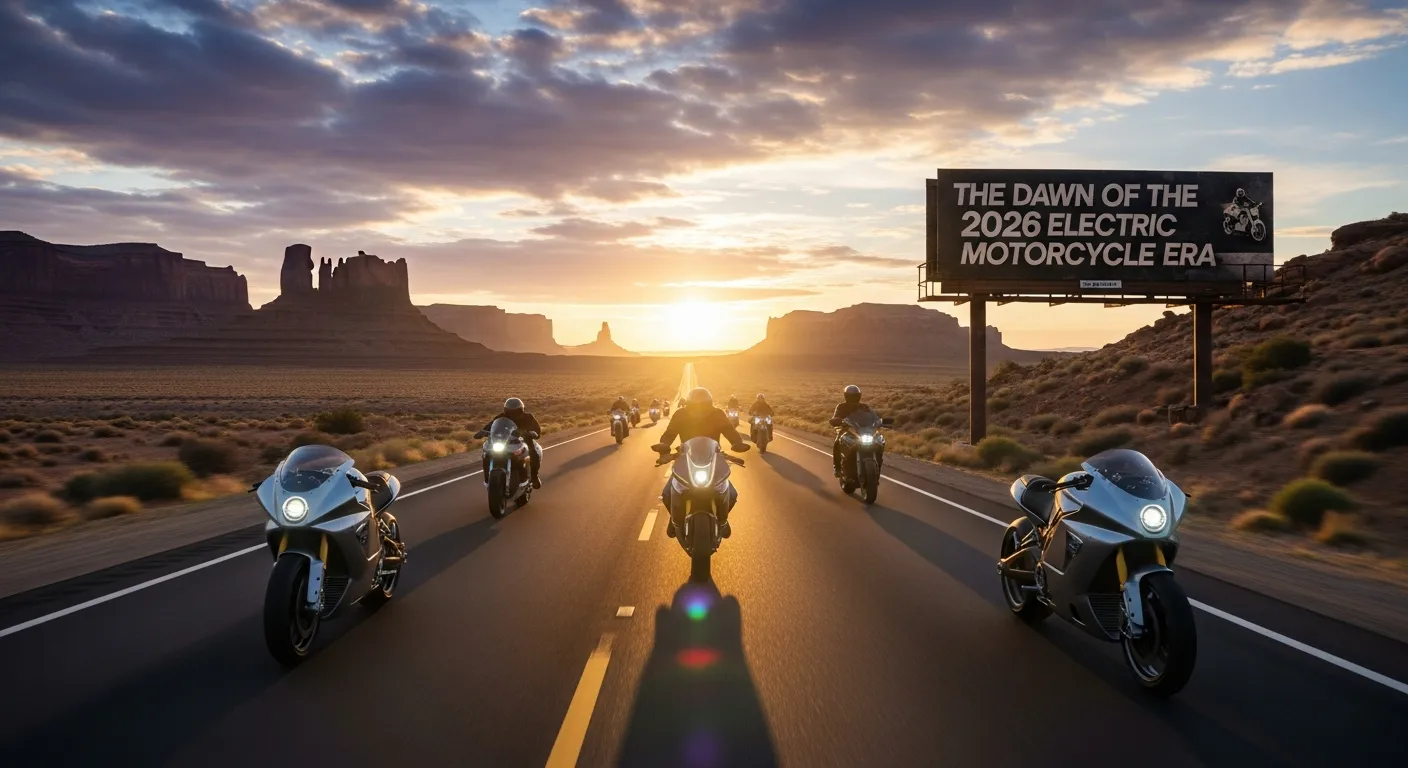There’s a quiet hum sweeping through the motorcycle world — and it’s not from a new exhaust system. It’s from batteries, motors, and a wave of innovation that’s turning heads across the riding community.
As 2026 approaches, electric motorcycles are no longer the “future.” They’re here, rolling onto streets from Los Angeles to London, reshaping what riders thought they knew about power and freedom.
Something about this shift feels different. Maybe it’s the surge of investment from legacy brands, or maybe it’s the growing realization that clean energy doesn’t have to mean compromise. Either way, the upcoming year promises to be a milestone — one that every rider, whether a die-hard petrolhead or curious newcomer, should pay attention to.
[IMAGE PROMPT: Wide cinematic shot of multiple electric motorcycles on a desert highway in the USA during sunrise — “The dawn of the 2026 electric motorcycle era.”]
Why 2026 Is the Year Everything Changes
If you’ve been watching the EV space closely, you’ll notice a pattern: the pieces are finally falling into place.
For years, electric bikes struggled with three main challenges — range, price, and charging infrastructure. In 2026, those roadblocks are beginning to disappear almost simultaneously.
Battery technology has leapt forward. The newest lithium-phosphate cells last longer, charge faster, and don’t need rare minerals. Add to that a stronger charging network across the U.S. and Europe, and suddenly, the math makes sense.
Perhaps even more important, prices are sliding down. With federal incentives and local EV credits, a midrange electric motorcycle could soon cost the same as a decent gas-powered sportbike.
That mix of affordability and convenience is what’s sparking this boom — not just environmental guilt. Riders aren’t buying electric bikes because they “should.” They’re buying them because they want to.

The Machines Leading the Charge
The 2026 lineup reads like a greatest hits album of innovation. Established names are finally going all-in, while new players are hungry to prove themselves.
| Model | Battery Capacity | Range (Claimed) | Top Speed | Charging Time | Est. Price |
|---|---|---|---|---|---|
| Harley-Davidson LiveWire S2 | 12 kWh | 160 miles | 115 mph | 45 mins | $15,999 |
| Zero SR/F (2026) | 14.4 kWh | 180 miles | 124 mph | 1 hr | $14,500 |
| Yamaha E-Tourer | 11.5 kWh | 140 miles | 110 mph | 50 mins | $13,999 |
| Ultraviolette F99 (US-Spec) | 10 kWh | 130 miles | 118 mph | 1 hr | $12,499 |
These aren’t toys or prototypes anymore. They’re full-fledged motorcycles with torque curves that rival midrange ICE engines. The Harley LiveWire S2, for example, delivers instant throttle response that feels almost supernatural when you twist the grip.
And what’s remarkable is how balanced these bikes feel. Engineers aren’t just chasing numbers; they’re chasing ride feel. You can sense it in the weight distribution, suspension tuning, and regenerative braking systems.

Once you ride one of these, it’s hard not to imagine how much quieter and smoother the future of motorcycling could be.
Range, Charging, and the Fading Fear of “EV Anxiety”
For most riders, “range anxiety” has been the biggest mental block. No one wants to run out of charge halfway up the Pacific Coast Highway. But in 2026, that fear is finally starting to lose its grip.
The U.S. Federal Highway EV Expansion Plan includes more than 2,000 new charging points designed for motorcycles, with compact bays and faster connectors. Riders can expect 20–80% charge in around 40 minutes — about the same time it takes to enjoy a roadside meal.
Real-world data is equally encouraging. A rider who commutes 50 miles daily could go nearly three days without plugging in. Weekend tourers can plan scenic routes with EV-friendly stops marked along major highways.
What’s more, the bikes are smart enough to calculate the best charging stops in real time. Apps sync directly with GPS navigation, predicting consumption based on terrain and speed.
In short: range anxiety is being replaced by range awareness — and that’s a big psychological win.
The Old Guard Strikes Back
When Harley-Davidson launched the first LiveWire, many skeptics laughed it off as a PR stunt. Now, those same critics are revising their opinions.
Legacy manufacturers like Triumph, Honda, and BMW Motorrad are preparing electric models that stay true to their riding DNA — power, precision, and comfort.
- Triumph’s TE-1 prototype, expected to debut in 2026, is rumored to have sportbike-level performance with near-silent delivery.
- Honda plans a U.S. rollout of its EM1 e: with modular, swappable batteries — an idea that could revolutionize touring.
- BMW’s Vision DC Roadster, once a concept, is inching closer to production with futuristic aesthetics and a low center of gravity.
It’s not just about replacing engines with motors; it’s about rethinking the soul of each brand.
When heritage meets high voltage, you don’t get nostalgia — you get evolution.
Counting the Costs: The EV Ownership Equation
Let’s be honest — motorcycling is as much about passion as practicality. But when passion starts saving you money, it’s a sweet bonus.
The total cost of owning an electric motorcycle is dramatically lower than that of a gas bike. There’s no oil to change, no spark plugs to replace, no exhaust maintenance. Even brake pads last longer thanks to regenerative braking.
A typical EV rider can expect to spend 40% less annually on maintenance and energy combined. Electricity per mile is a fraction of what gasoline costs, especially in regions with renewable power grids.
Insurance is also catching up. Major providers in the U.S. are introducing green vehicle discounts, rewarding riders for choosing eco-friendly transport.
If you enjoy reading about real-world numbers, our finance section dives deeper into cost-benefit analyses for modern riders — from insurance trends to resale projections.
Going electric isn’t just good for the planet — it’s good for your pocket, too.
The Culture Shift: When Silence Becomes Power
Motorcycling has always been about sound — the deep growl of an engine, the mechanical heartbeat under you. But today’s younger riders are redefining what power feels like.
To them, silence isn’t the absence of thrill — it’s the sound of progress. The subtle whine of an electric motor, the instant torque, the futuristic interface — all these elements create a new kind of riding pleasure.
Riders are also embracing the connected tech side: helmet displays with navigation, voice commands, and apps that monitor battery health. Riding feels less mechanical and more intuitive.
And there’s something to be said about the experience itself. Imagine gliding through winding roads without the constant roar, hearing the breeze, the tires, and your own thoughts. It’s meditative.
For a new generation, the thrill isn’t in the noise — it’s in the flow.
Should You Wait or Buy Now?
If you’re sitting on the fence about buying an EV bike, 2026 is a tricky — yet exciting — year.
If your daily commute is short and you already have access to charging at home or work, there’s no reason to wait. Today’s models are reliable, quick, and loaded with features.
But if you’re an adventure rider planning cross-country trips, patience might pay off. The upcoming 2026 models will likely pack better range, lighter battery packs, and refined ride dynamics.
Ultimately, it depends on your riding style. City commuters will benefit immediately, while tourers might appreciate waiting for second-generation technology.
Sometimes, waiting one more riding season can buy you a lot more miles.
Final Thoughts
The 2026 electric motorcycle boom isn’t just an industry shift — it’s a cultural milestone. For the first time in decades, the motorcycle world feels like it’s accelerating toward something fresh, not just refining what already exists.
The bikes are smarter, the designs are bolder, and the experience feels surprisingly pure — closer to flight than driving.
Yes, there will be hiccups: infrastructure gaps, tech bugs, and traditionalists who’ll miss the roar. But for every rider who’s ever dreamed of the next frontier, this might be the moment they’ve been waiting for.
If you’ve been waiting for a sign to rethink what riding means in the modern age, this might just be it.
